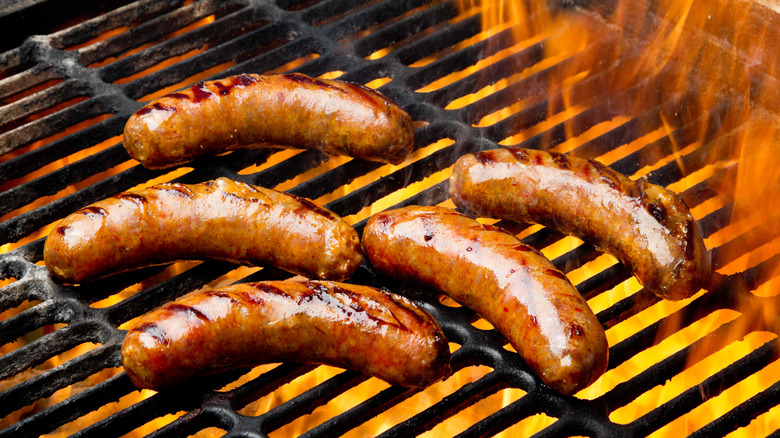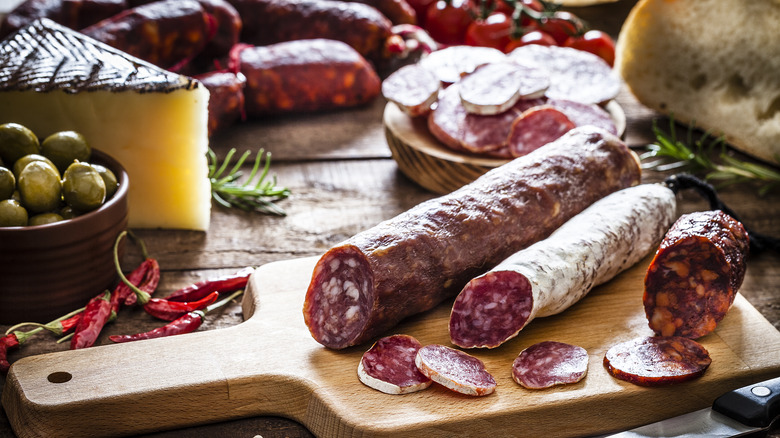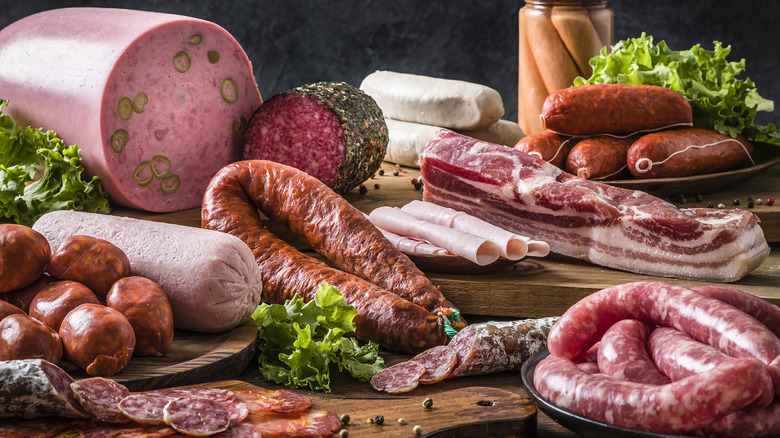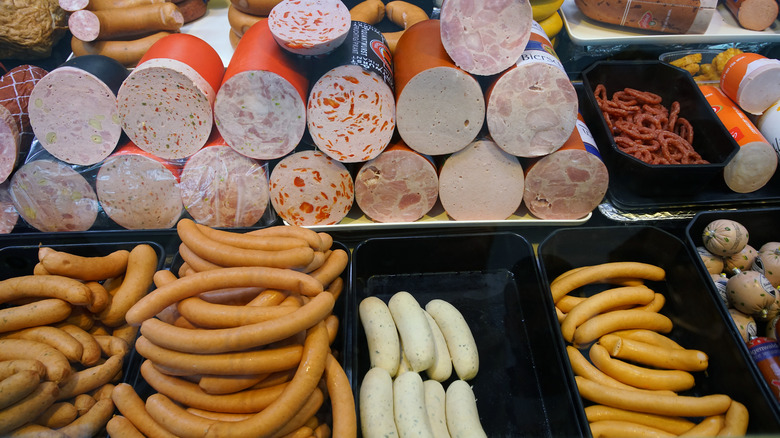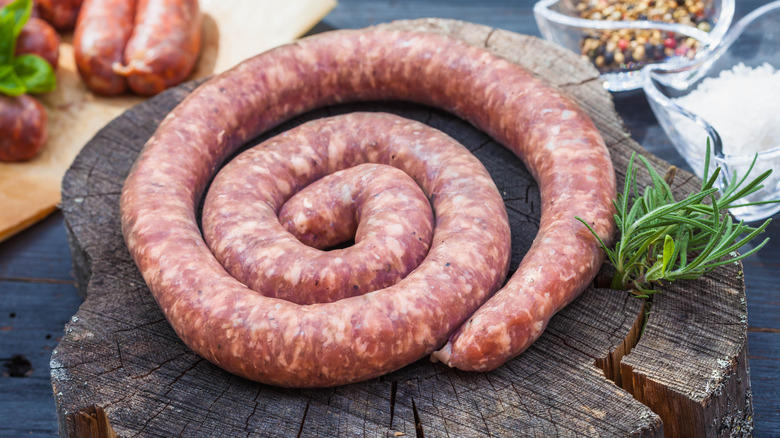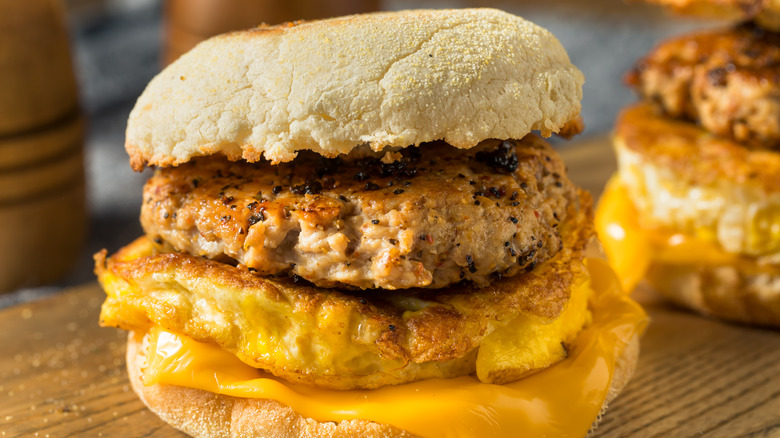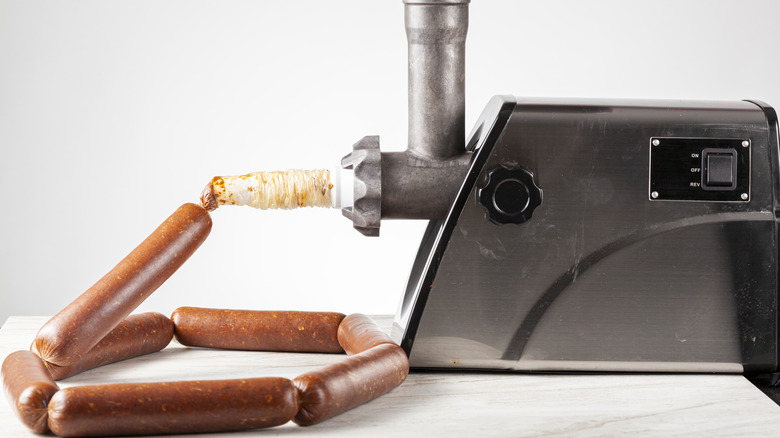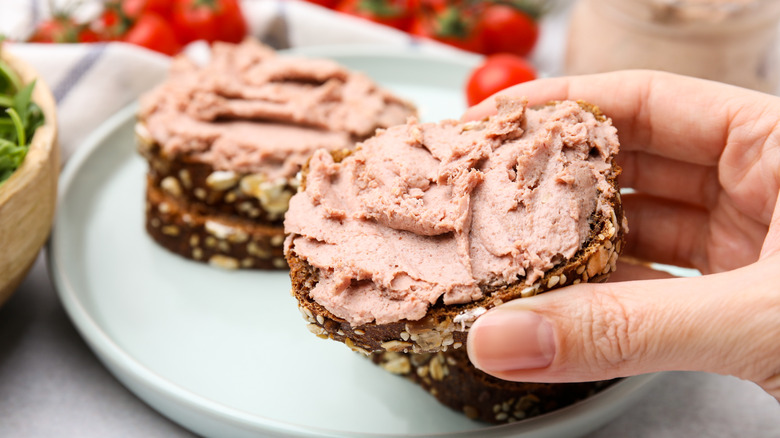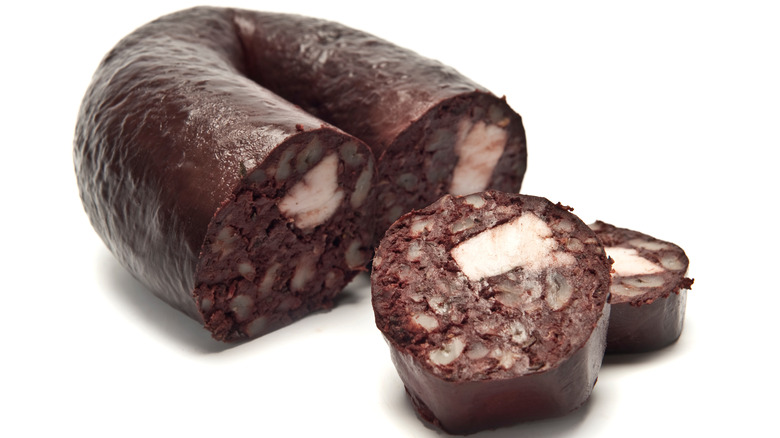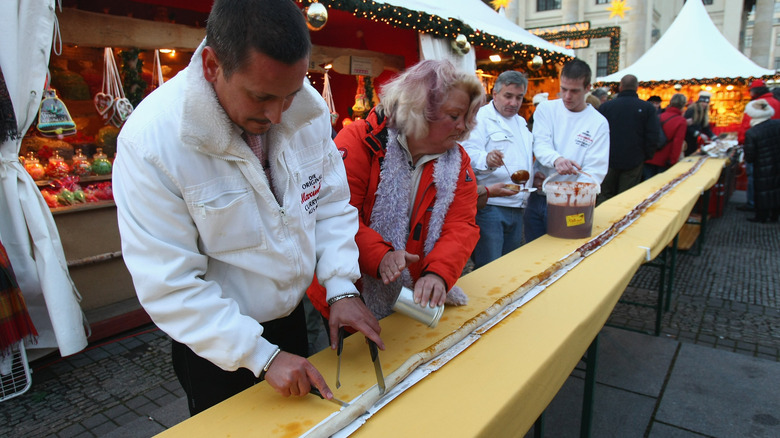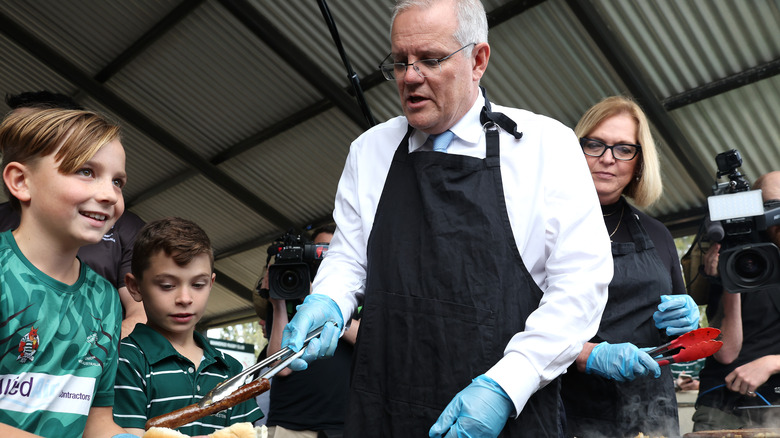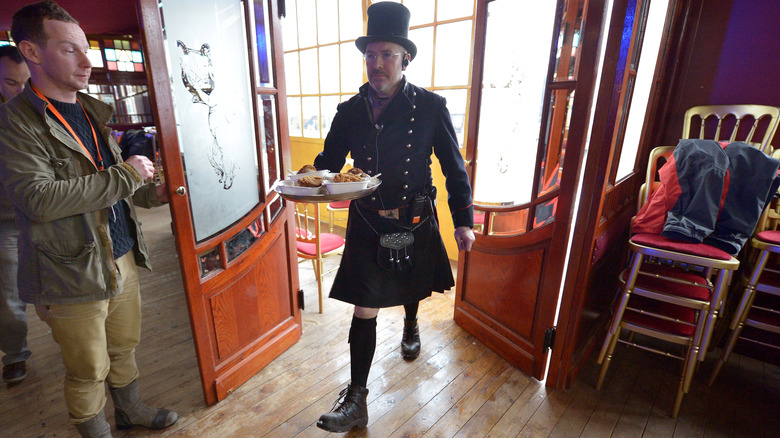Everything You Need To Know About Sausage
Whether links or patties, spiced with chile or sweetened with fennel or soy, for breakfast alongside hash browns or dinner atop a creamy, cheesy potato purée, sausage is found — and beloved — pretty much the world over. And that's no surprise: Sausage-making is a great way to use up scraps of meat that might otherwise go to waste, and dry-curing them is an excellent way to preserve them for weeks or even months. The results are as diverse as they are delicious.
But despite its ubiquity, you'd be surprised to learn that sausage holds many mysteries, from its origins in Mesopotamia to modern attempts to make the most massive iteration possible. And that's not all: Sausage has a seedy underbelly, long attributed with a host of potential health hazards. Despite the suspicion that has long surrounded what some consider mystery meat, it continues to be made all over the world, with one country in particular boasting a thousand varieties alone. Want to know which one — and discover a host of other sausage-related mysteries? You've come to the right place.
Sausage was first invented in ancient Mesopotamia
While many countries and regions around the world lay claim to pre-Common Era sausages, it's the ancient Sumerians we have to thank for the world's first — at least according to experts. Four-thousand-year-old texts reference meat stuffed into casings made from intestines, which is evidence of sausage-making in ancient Mesopotamia. It would take another 2,000 years for sausage-making technology to develop in Turkey, where sausages known as sujak were invented, spiced heavily with sumac, cumin, and garlic. The forcemeat likely developed in Greece at around the same time if references in Homer's "Odyssey" to sausages made from goat meat and blood are any indication.
China's earliest sausage likely dates to around 580 B.C.E., and it would take the ancient Romans another thousand years or so to get onboard. And while Brits these days would be lost without their bangers and mash, the first British sausages weren't even developed until the 7th century C.E.
Sausage was originally invented to preserve meat
Many of the most delicious staples we now enjoy were born of the same goal: food conservation. From jams and jellies, first developed as a means of ensuring fruit could be enjoyed long past its season, to cheese, whose technology was mastered to keep milk around through the lean winter months, food conservation has given rise to some of our favorites.
The origins of sausage are similar. Gary Allen, author of "Sausages: A Global History," told Atlas Obscura, "Sausages were created originally for two reasons: One, to make use of every little piece of the meat, so nothing is wasted, and two, by using salt and smoking, it was a way to preserve it."
Different methods may be used to help sausages gain a longer shelf life. One method is smoking, which creates a protective layer on the outside of the meat and infuses the sausage with a rich flavor. Sausages may also be fermented, as the ancient Babylonians did beginning in 1500 B.C.E. Salting is another popular method of preservation; in fact, the very word "sausage" comes from the Latin "salchichon," meaning "little salt pig." Dry-curing, meanwhile, extends a sausage's shelf life by reducing its moisture content, resulting in chewy, hard salami and saucissons sec that make the perfect sandwich filling or snack to enjoy with pre-dinner drinks.
Sausage is made all over the world
These days, nearly every country in the world has its own version of sausage, suited to the local climate and customs. While sausages can be made of almost any meat, pork is preferred in most traditions, in large part thanks to the unique coagulating properties of pork fat. Binders like oats may be used, and different seasonings like spices and herbs, or even cheese may be added, depending on local tastes and availability.
The heavy hand used to spice Turkey's sausages has helped them to withstand the warmer temperatures of the local climate, and the prevalence of horses in this region of the world led notably to the development of a horse sausage that's still popular to this day. In North Africa, similar warm temperatures meant merguez was also heavily spiced, and religious preclusions to pork led it to be developed with beef or mutton. In Italy, sausages are often studded with local bounty like olives and pistachios, and in Mediterranean countries like Southern Italy, Southern France, Greece, and Spain, warm temperatures led to the development of dry-cured salami, which were easier to make in the drier regions and boast a longer shelf life than their fresh counterparts.
Germany has around 1,200 different types of sausage
While sausage exists the world over, there's perhaps no country that can hold a candle to the sheer variety that is Germany's wurst bounty. Home to around 1,200 different kinds of sausage, Germany is definitely a contender for the world's sausage crown. Perhaps the most popular and well-known German sausage is bratwurst, made with a combination of pork and beef seasoned with marjoram and caraway. But you'll also find beef-based, garlic-infused knackwurst or bregenwurst, a looped sausage that was once made with brains, though now it's mainly made with belly. Bavarian weisswurst, a white sausage made with minced veal and beef, is so fresh and perishable that it's traditionally only eaten before noon; any later, and it risks spoiling (especially in pre-refrigeration days).
That Germany loves its sausage should come as no surprise. Visitors to Berlin will even find a museum devoted to currywurst, a local favorite since the late '40s, when cheap sausages were seasoned with curry powder to hide their subpar flavors. These days, the creation born in times of austerity is beloved in the German capital, where it's typically served with ketchup for dipping.
Some sausages have luxe appeal
It shouldn't come as a surprise that sausages have long been considered a poor man's food. After all, while the rich had access to large pieces of meat, the poor would have to make do with scraps, extending them with fillers and lengthening their shelf lives to ensure they would still have access to food in times of lack. But over time, some sausages have been considered luxuries.
Such is the case of the frankfurter, granddaddy to the hot dog. In the 16th century, this sausage was served at the coronation of the Holy Roman Emperor, who was crowned in the sausage's native city of Frankfurt. Southern French Toulouse sausage, meanwhile, is a delicacy made with only the best cuts of pork belly and leg, often marinated in red wine for at least a day before being assembled into a chunky sausage simply seasoned with local salt and pepper. In 1992, the creation earned a French Label Rouge, a distinction that protects the recipe and precludes the use of any colorings or preservatives. It's a key ingredient in a cassoulet recipe, a local bean and meat stew.
Sausage doesn't just come in link form
What actually makes a sausage a sausage is a matter of some debate. Generally made of either chopped or ground meat, sausages tend to be "forced" or extruded into a casing, which are then "linked," dividing the long rope of meat into portion-sized lengths. But sausages don't necessarily have to come in link form.
While some would technically term it a pudding, Scottish haggis is typically ball-shaped. Sausage can also be sold in patties, which, in lacking a casing, can brown up even crispier than links. They're also the perfect size and shape for breakfast sandwiches like the McDonald's classic sausage McMuffin. Some sausages are spreadable, like spicy Calabrian 'nduja. And sausages can even be square, as with the Scottish Lorne sausage, a square beef patty seasoned with spices and bulked out with breadcrumbs. It's so unique that Scottish actor James McAvoy used it as a reference to his Scottishness on an appearance on Graham Norton's nighttime talk show, quipping that despite his propensity for playing Englishmen, he is "the full square sausage."
Sausage casings can be made from a variety of different substances
Link sausages get their shape thanks to the casing into which they are forced. This thin membrane holding them together crisps up when cooked, offering a satisfying snap when you take a bite. Traditionally, in true nose-to-tail form, this casing is made from intestine, though these days, this is far from the only option available. In the 1960s, scientists innovated methods for crafting synthetic sausage casings made from animal hide. These casings, which are also called collagen casings, may attempt to replicate the real thing, but most experts agree they can't compare with the real deal. Neither, for that matter, can the plastic casings used to keep some dry-cured French sausages together. These artificial casings are inedible and should be removed before digging in.
Of course, if you're eating a vegetarian sausage, neither intestine nor hide will appeal, and plastic is a no-go on fresh sausages you must cook before serving. Luckily, there are vegetarian casings on the market as well, often made with glycerin, starch, or seaweeds like carrageenan, which is frequently used as a thickener or stabilizer in everything from coconut milk to store-bought chicken.
Some sausage contains offal
People often assume that because sausage is made of minced or chopped meat, it must be hiding bits and pieces no one really wants to eat. And if you're put off by offal, this may well be the case. Sausage recipes around the world contain flavorful organ meats like kidney, liver, and heart, which add flavor and texture to sausages and ensure no part of the animal is wasted. Liver sausage, in particular, is popular in Germany, where pork liver and meat are combined to form smooth sausages that may be firm enough to cut into slices or creamy enough to spread on bread.
But liver isn't the only offal to find its way into its own sausage. French andouillette is a tripe sausage with a powerful, pungent aroma many disguise with mustard sauce, and Polish kiszka mózgowa is made mainly with brains — though it may also feature heart, lung, tongue, liver, or even skin.
Some sausage is made with blood
Many sausages, from French boudin noir to British black pudding, Spanish morcilla to Korean soondae, feature blood as a key ingredient. These sausages, often euphemized with the word "black" instead of "blood," are beloved for their deep flavor and richness in iron. The very definition of nose-to-tail butchery, blood sausage is typically first made when a pig is slaughtered, given the short shelf life of its core ingredient.
Traditions for preparing and serving blood sausage vary, depending on the region. In the U.K., black pudding is usually bulked out with oatmeal or breadcrumbs and served for breakfast as part of a "full English" or "full Scottish." Spanish morcilla often contains rice and is typically served as a tapa. Korean soondae often sees the blood combined with cellophane noodles and glutinous rice for a chewy textured sausage seasoned with chili, sesame, and dried shrimp. In France, meanwhile, blood sausage is rarely bulked out with fillers, uniting a simple combo of blood, onions, and fat. The resulting dish is often served with sautéed apples and potatoes.
Eating sausage could be considered a health risk
It should come as no surprise that sausage is anything but a health food, seeing as it tends to be high in both saturated fat and sodium. But nutritional content aside, sausage has also been implicated in far more worrisome health issues. Given their propensity for cobbling together bits and pieces of meat, sausages have long borne the brunt of much suspicion — and this dates back as far as the 10th century or even earlier. In the 19th century, botulism was so heavily associated with sausage that one German doctor dubbed the disease "sausage poisoning," and many 19th- and 20th-century food poisoning outbreaks over time have been linked to sausage.
Even if your sausage hasn't been contaminated, however, modern science has given lovers of the cured meat pause. A 2022 study in Foods found that the nitrites in cured meats could prove to be a health risk, contributing to the formation of carcinogenic nitrosamines when sausages are grilled or cooked over high heat. And a 2008 study in the International Journal of Pediatric Otorhinolaryngology showed that hot dogs were the food item "most often associated with fatal outcomes" in children due to airway obstruction.
Many have attempted to create the world's largest sausage
Whether it's the innately funny shape or just humanity's unending desire to create the world's biggest, longest, or largest of anything, many have endeavored to craft the world's most imposing sausage. In Texas, Chef Brian Luscher collaborated with Local Yocal Market to craft a 249-footer, which they then smoked on a mobile smoker. In 2008, Leo Friedrich of Maximilian Meat Specialties, prepped a 40-meter currywurst at the Gendarmenmarkt Christmas market in Berlin. A 6-foot mortadella made by Italian salumeria Veroni became the largest of its kind in 2019, and a Cumberland sausage measuring 3.3 meters in diameter became the world's largest iteration of this traditional British sausage formed into a ring in 2012. In Mundate, Alberta, meanwhile, a 42-foot tall fiberglass sausage, erected to reflect the importance of local Ukrainian culture, may well have become the world's tallest sausage in 2001, albeit an inedible one.
The world record for the longest sausage full stop is currently held by Romanian Carrefour supermarket and local meat producer Aldis. In 2014, they defeated the previous 59.14-kilometer record, set in October 2000 in the U.K., with a sausage measuring a whopping 62,745 meters. Part of the sausage was donated to charity, while the rest was available for tasting by those who attended a celebration in its honor.
Sausage is a prominent fixture of Australian politics
Australians may not actually say "shrimp on the barbie," but they do love themselves a cookout. Case in point: the tradition of "democracy sausage," which sees voters rewarded for exercising their suffrage with a sizzling sausage. This tradition, which dates back to the '80s, sees the schools, churches, or community organizations like surf clubs that typically host polling stations during elections grilling and selling sausages. The goal is twofold: Not only does this provide a meal for voters, but it also allows these associations to raise funds for their local communities.
While the tradition doesn't increase voter turnout, seeing as voting is compulsory in Australia, it does seem to make it more fun, and for many public personae, including former Prime Minister Malcolm Turnbull, it's a wholly Australian tradition. "Australian democracy is not complete without the aromas of a sausage sizzle," he told The Guardian in 2016.
At the Highland Games, you can hurl a haggis (and on Burns night, you can sing to it)
Scottish haggis is a sausage that defies definition. Scotland's national dish, this pudding contains the liver, heart, and lungs of a sheep, all of which are stuffed into a sheep's stomach alongside suet, oatmeal, and seasonings. The resulting near-sphere of sausage is typically boiled and served alongside "neeps and tatties" (turnips and potatoes).
The specialty was immortalized by Robert Burns' poem "Address to a Haggis," which is traditionally declaimed with much ceremony on both New Year's Eve and Burns' birthday, January 25. The haggis is typically first carried into the festivities to bagpipe fanfare and addressed by the orator of the poem before being stabbed, sliced, and served.
This isn't even the most out-there tradition linked to humble haggis. The Highland Games often feature Haggis hurling, a feat of throwing a haggis as far as you can. This tradition ostensibly dates to a time when Scottish women would bring lunch to their husbands at work in the fields, tossing the meal over streams and rivers to the lads waiting to catch it in their kilts. These days, it's as much a feat of strength, former victors say, as one of technique — especially if you don't want the haggis to burst.
